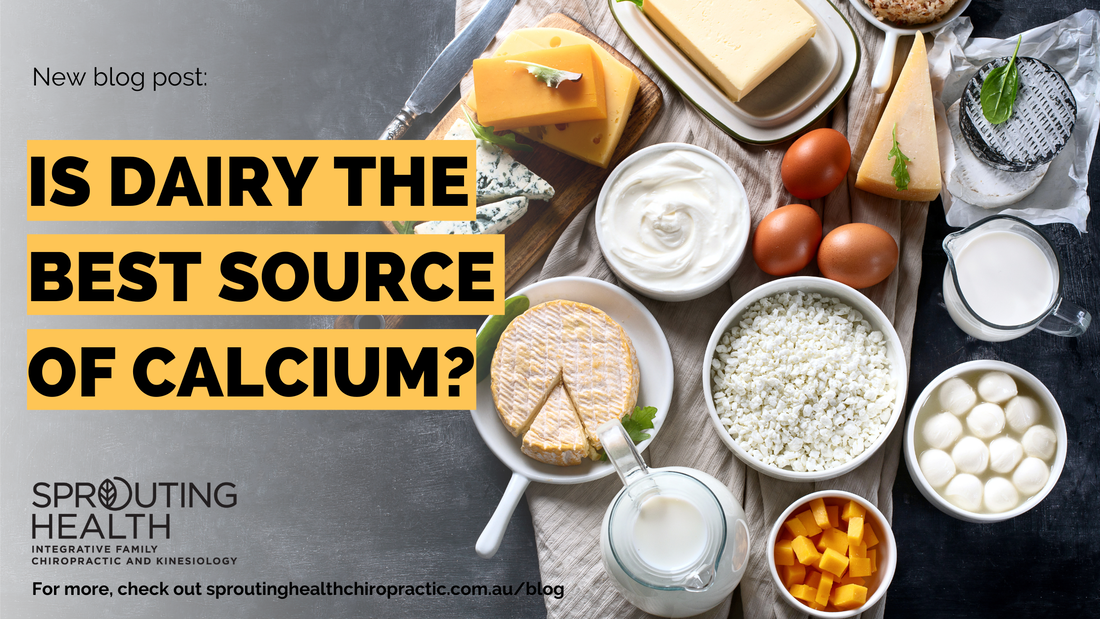?Today, we want to talk to you about an extremely common discussion that we have in practice around gut health; calcium vs dairy. We have been taught for years that dairy is an excellent source of calcium, but it...
?Today, we want to talk to you about an extremely common discussion that we have in practice around gut health; calcium vs dairy. We have been taught for years that dairy is an excellent source of calcium, but it is time to challenge the status quo?
Calcium is very important to enhance bone mineral deposition, and low calcium intake in children can contribute to rickets in combination with poor vitamin D and genetics. Currently it is recommended that infants have 300mg/day, children have 500-800mg/day and adults have 800-1000mg/day. (1-6)
We also know that calcium is important in the prevention of osteoporosis. A 12 year Harvard study of 78,000 women who drank 3 glasses of milk a day had a higher risk of hip and forearm fracture than those who dank one or less glasses per week. Another study from Sydney found high dairy consumption was associated with an increased risk of fracture. The countries with the highest rates of osteoporosis (US, England, Sweden & Finland) are the ones where people drink the most milk. (1-4)
So, now we come to the dairy challenge. Yes, it is high in calcium, but the bioavailability is actually rather low (30%), especially when compared with other sources such as brussels sprouts (64%), mustard greens (58%), or broccoli (53%). In fact, the animal proteins in dairy increase the excretion of calcium through urine. It has also been suggested that the daily recommended quantities are linked with increases in the risk of cancers, autoimmune diseases, ear infections and allergies in children, heart disease, and diabetes. (1-3)
What can I do to help my bone health if dairy is not the answer? Well, increasing fruit and vegetable intakes will help, limiting animal proteins, regular exercise and getting enough vitamin D.
Lanou A.J., Berkow S.E., & Barnard N.D. Calcium, dairy products, and bone health in children and young adults: A reevaluation of the evidence. Pediatrics. 2005: 115; 736.Lanou A.J. Should dairy be recommended as part of a healthy vegetarian diet? Counterpoint 1-3 Am J Clin Nutr 2009; 89 (Supp): 1638S-42S.American Academy of Pediatrics – Committee on Nutrition. Calcium requirements of Infants, Children & Adolescents. Pediatrics 1999;104(5):1152-1157.Feskanich D., Willett W.C., Colditz G.A. Calcium, Vitamin D, milk consumption, and hip fractures: a prospective study among postmenopausal women. Am J Clin Nutr. 2003; 77: 504-511.Cumming R.G. & Klineberg R.J. Case-control study of risk factors for hip factures in the elderly. Am J Epidemiol. 1994 Mar 1;139(5): 493-503.Welten D.C. et al. Weight-Bearing activity during youth is a more important factor for peak bone mass than calcium intake. J Bone Min Res. 1994; 9(7): 1089-1096.
Calcium is very important to enhance bone mineral deposition, and low calcium intake in children can contribute to rickets in combination with poor vitamin D and genetics. Currently it is recommended that infants have 300mg/day, children have 500-800mg/day and adults have 800-1000mg/day. (1-6)
We also know that calcium is important in the prevention of osteoporosis. A 12 year Harvard study of 78,000 women who drank 3 glasses of milk a day had a higher risk of hip and forearm fracture than those who dank one or less glasses per week. Another study from Sydney found high dairy consumption was associated with an increased risk of fracture. The countries with the highest rates of osteoporosis (US, England, Sweden & Finland) are the ones where people drink the most milk. (1-4)
So, now we come to the dairy challenge. Yes, it is high in calcium, but the bioavailability is actually rather low (30%), especially when compared with other sources such as brussels sprouts (64%), mustard greens (58%), or broccoli (53%). In fact, the animal proteins in dairy increase the excretion of calcium through urine. It has also been suggested that the daily recommended quantities are linked with increases in the risk of cancers, autoimmune diseases, ear infections and allergies in children, heart disease, and diabetes. (1-3)
What can I do to help my bone health if dairy is not the answer? Well, increasing fruit and vegetable intakes will help, limiting animal proteins, regular exercise and getting enough vitamin D.
Lanou A.J., Berkow S.E., & Barnard N.D. Calcium, dairy products, and bone health in children and young adults: A reevaluation of the evidence. Pediatrics. 2005: 115; 736.Lanou A.J. Should dairy be recommended as part of a healthy vegetarian diet? Counterpoint 1-3 Am J Clin Nutr 2009; 89 (Supp): 1638S-42S.American Academy of Pediatrics – Committee on Nutrition. Calcium requirements of Infants, Children & Adolescents. Pediatrics 1999;104(5):1152-1157.Feskanich D., Willett W.C., Colditz G.A. Calcium, Vitamin D, milk consumption, and hip fractures: a prospective study among postmenopausal women. Am J Clin Nutr. 2003; 77: 504-511.Cumming R.G. & Klineberg R.J. Case-control study of risk factors for hip factures in the elderly. Am J Epidemiol. 1994 Mar 1;139(5): 493-503.Welten D.C. et al. Weight-Bearing activity during youth is a more important factor for peak bone mass than calcium intake. J Bone Min Res. 1994; 9(7): 1089-1096.











